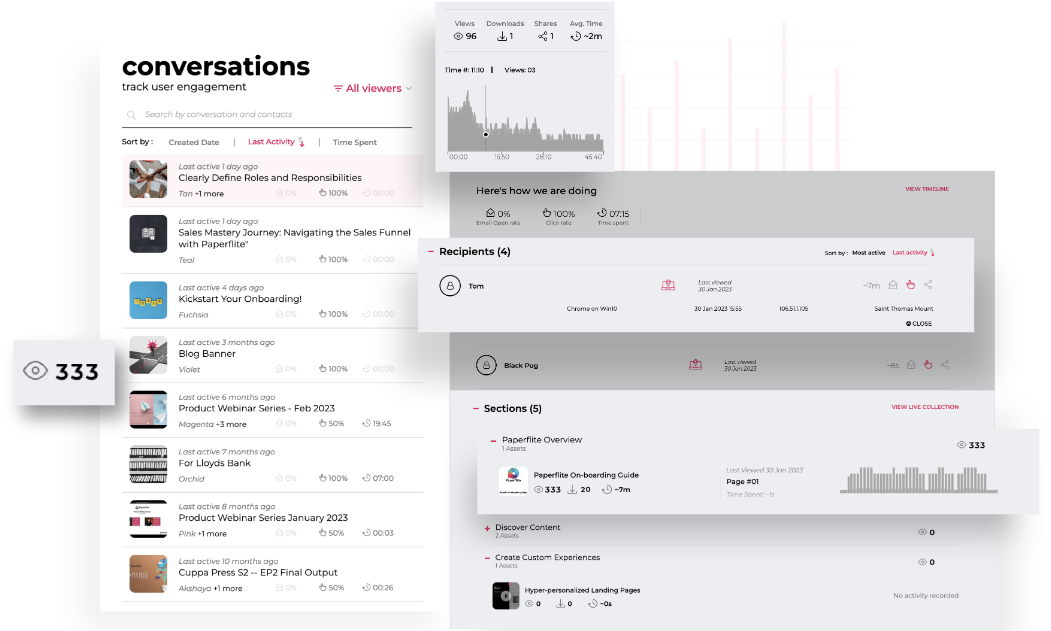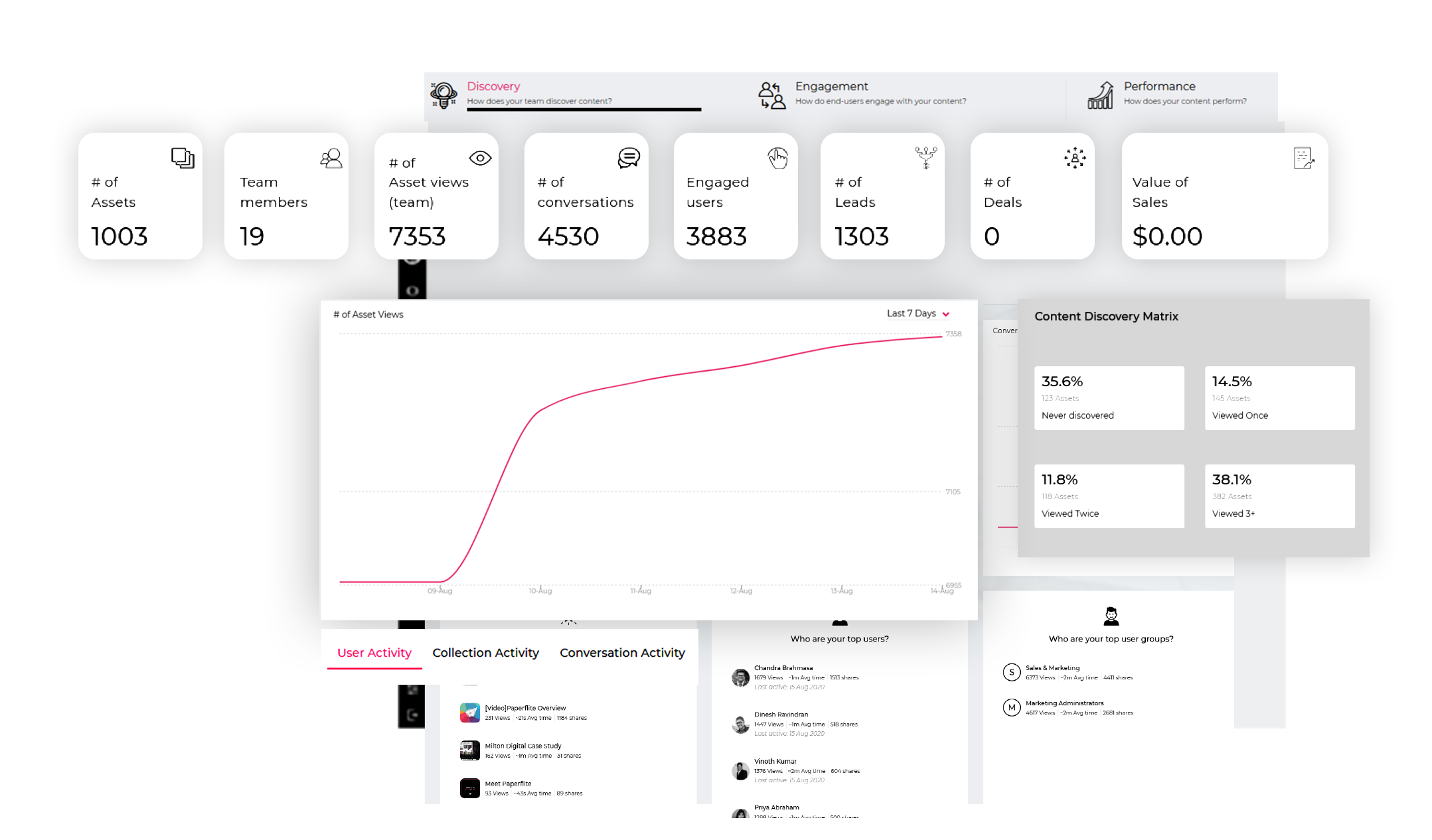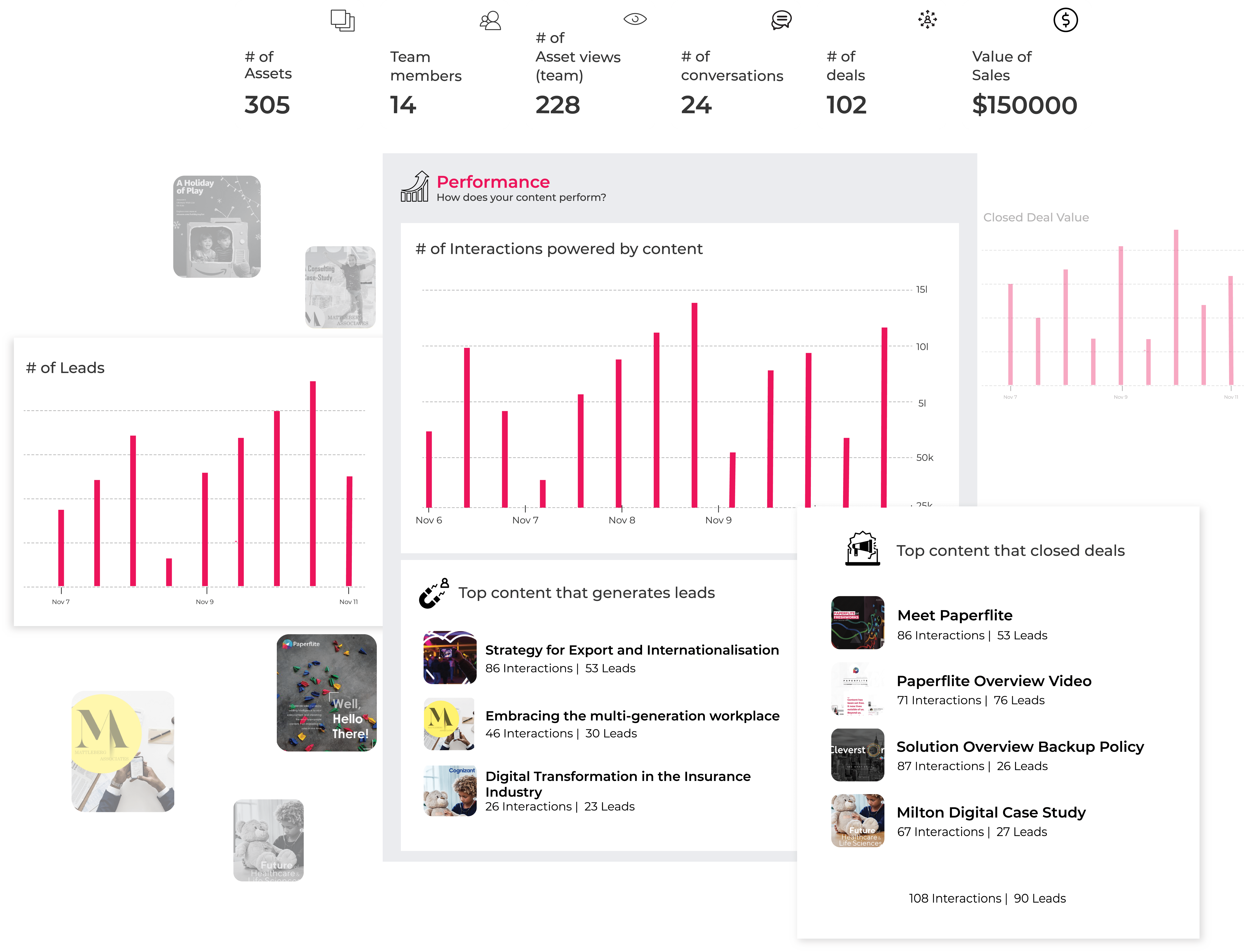What is content tracking? Types, Techniques, and Tools
This blog will serve as your ultimate guide in understanding content tracking.
We woke up when September ended, and now October is right around the corner.
Anddd, it’s almost Halloween!
Whip out the costumes, the candy and the collection of horror movies we carefully tucked away after too many almost cardiac arrests.
Speaking of horror movies, ever noticed how every spirit seeking revenge knows almost exactly where its wrong-doers are, what they do, what their schedule is, precisely when they pick up their Starbucks and so much more? With this very valuable information, the spirit knows exactly when to strike and give a good ol’ jumpscare to the unsuspecting chap on screen.
Lots of trickin, treatin’ and trackin, as well.
Almost makes us wonder what amazing tracking capabilities our dear spirit possesses. No pun intended.
Speaking of tracking - how awesome would it be if our GTM teams could track exactly where all the content being churned out is distributed, how it’s performing and enabling them to know exactly when to strike next, with a sales follow-up? (NOT, a jumpscare)
We agree, it would be pretty awesome. Apart from being awesome, it is also very possible. Keep it scrolling to find out about content tracking, why you need it and other more awesome stuff.
What is content tracking?
Content tracking is the process of monitoring and analyzing the performance of the content you post on your website, application, or social media, such as blogs, news articles, videos, pop-ups, and other page elements. This data-driven approach involves measuring KPIs like viewer engagement and conversion rates to tailor content strategies based on audience preferences.
In a nutshell, Content Tracking enables you to track metrics, analytics, engagement rates and uber-specific numbers pertaining to your content’s overall performance. This could be anything from website performance to the performance of individual content pieces.
But we aren’t here for any of the “in a nutshell” business. We’re here to give you the whole scoop from the Nutella jar and tell you all you need to know about content tracking.
Naturally, when we talk about such metrics, Google Analytics is probably the first result that pops up in your search engine head. Rightfully so. Web analytics tools are stellar in providing numbers such as the number of users (new and existing), number of sessions, bounce rates, average engagement time and average session duration.
Content tracking across various web analytics platforms can give you metrics such as :
- Average time spent on a particular page
- Number of users who have landed on a page
- Bounce rates
- Average session duration
Get Actionable Insights That Moves Sales Forward
However, it is important to keep in mind that these platforms are exclusive to website traffic unless integrated with the other members of the marketing fam such as online advertising platforms, search management platforms and the whole lot.
This is where content tracking platforms step in as a game changer with their clearly defined metrics and analytics features, amongst multiple others.
Content tracking features provided by content management systems are :
- Amount of time spent on a particular piece of content/asset
- When it was last viewed
- Amount of times it was downloaded
- In the presence of a gating form - the email address of the reader
- Number of leads generated
Given such specific metrics, you can :
- Tweak your existing content strategy
- Identify what content works
- Identify what content doesn’t work
- Repurpose existing content based on what performed well
- Curate fresh content that will certainly garner results
- Form patterns for curating well-performing content
Integration of effective and user-friendly content management platforms with analytics platforms such as Google Analytics is nothing short of a superpower in the hands of your Sales & Marketing teams.
Why is content tracking important?
businesses need to manage their content across various platforms. This goes beyond creating content but ensuring it achieves its purpose whether updating customers, bringing more traffic, or driving sales.
Hence, content tracking is a must-have for sales and marketing teams. By scrutinizing current content, you can optimize marketing strategies in a way that would gauge potential customers to your business.
Similarly, you can discover what works best when converting leads into loyal customers. The result would maximize your content ROI i.e. you get maximum benefit from the content you create.
Apart from points mentioned above - content tracking can also help you with processes that will help you make the most of your content, such as :
Measuring the performance of your content
With content tracking, you can measure your content’s performance based on quality, interactions, view time, medium of sharing and more such specifications.
Measuring the performance of your content can be further divided into the 2 W’s and an H.
Who

Given the inclusion of a gating form in your content - it is possible to track the following :
- Who is viewing your content?
- Who are they sharing your content with?
This feature greatly helps with prospecting as you can closely track the recipients engaging with your content and pick the right prospects to pitch your product to. With this information, you can narrow your prospects list after conducting adequate research on the viewers.
What

Content tracking allows you to track metrics and analyze individualized pieces of content such as PDFs, whitepapers, videos, YouTube video links, blog links and pretty much anything that’s virtually shareable. These metrics help you in making a qualitative analysis of your content.
With content tracking, you can track the following :
- What content is performing well? (increased number of engagements, views and sharing)
- What is the content engagement rate over a particular time frame?
With this information, your marketing team can make informed decisions for the next content cycle based on which content performed well and what did not.
How

While tracking your content, content tracking tools also allow you to view how your content is being shared. Content tracking tools enable you to share personalized assets in various ways such as through email integration, campaigns, personalized links and anonymous links.
You can precisely view through which medium your recipients have shared your content.
- How does content tracking help generate ROI?
With content tracking, you directly measure the success of your content marketing efforts. Content tracking, metrics and analytics provide us with ample data. However, interpretation of the data is what will garner ROI for your business. As established, content tracking helps identify which content patterns work best for your brand voice - this helps in eliminating the additional expenses on running multiple AB testing campaigns, experimenting with different collateral and so on.
Get Granular Information About Every Content Being Sent
Let’s break it down a little further and see how content tracking can benefit your sales and marketing teams.
Content tracking for marketing
For the lack of a better phrase and for our undying love for peanut butter, we’d like to start this sub-section by saying that -
“Content tracking and marketing go together like peanut butter & jelly”.
Here are some of the reasons why your company and your marketing team deserve a content tracking tool for those endless hours of brainstorming and colossal content churning they do :
Know what content generates leads
With content tracking capabilities hooked onto your utility belts, you can effortlessly view and track the performance of your content across all platforms. Apart from performance numbers, content tracking softwares also provides metrics on which content generated the most number of leads.
With this information, your marketing team can generate content specifically for prospecting purposes such as social media campaigns, LinkedIn Ad campaigns, Google Ad campaigns, etc and know exactly what content to include in order to generate maximum leads.
Identify a winning content strategy
Quickly circling back to our content strategies discussion, curating content strategies are one thing. Creating content strategies that actually work are a whole ‘nother thing.
As painful as it sounds, content strategies may or may not provide you with the outcomes your marketing team may seek due to multiple factors such as ever-changing algorithms, an abundance of content trends, tons and tons of content being churned out by millions of industries every minute, and so on.
With content tracking softwares, you have the freedom of distributing content in pockets after applying various content strategies and getting in-depth analytics of which strategies worked and which did not. In turn, allowing you to eliminate the strategies that do not yield results.
Content tracking for sales
The first step to tracking sales content is bidding adieu to send files as individual attachments in emails and switching to personalized microsites.
Collaterals such as whitepapers, case studies and PDFs prove to be useful in different points of the sales process. The presentation of content is just as important as the content itself. For instance, we can all collectively agree that the best part of receiving your online packages is opening them like a gleeful child on a Christmas morning. :)
When you send across sales collaterals post sales calls, sending them as pretty, personalized and oh-so-trackable packages called microsites come with a plethora of benefits.
These benefits include :
Track when prospects engage with the content
Say goodbye to your post-sales call anxiety by knowing exactly when your prospects are engaging with the content sent. An email will be delivered to your inbox as soon as a prospect engages with your content and proceeds to provide you with metrics and analytics about the same.
An additional perk of content tracking is that real-time notifications keep you updated on exactly when prospects engage with the content sent to them, so sales executives know when to conduct their routine follow-ups. This speeds the sales process up and also garners the prospect’s attention. Hey, it’s all about being at the right place at the right time. Right?
Personalize conversations with your prospects
Now that we are equipped with all the details such as which content your prospect has engaged with the most and more such details that help you tailor personalized conversations. Now that you know what interests the prospect, you can tailor personalized followups that emphasise on their area of interest.
Identify and distribute content that closes deals
Identify and aptly distribute content that is known to close deals with efficiency. Keeping your sales content distribution short, crisp and informative is the key to ensuring all your content is consumed by your prospects. Nobody wants to open an email or microsite that is stacked with a gazillion documents.
With content tracking, you can quickly analyze and pick out the content that is efficient at closing deals and proceed to include only those pieces in your next sales process.
Apart from this, metrics such as reshares, downloads and increase in time spent clearly showcase the interest of the user & the intent of the deal.
Difference Between Marketing Content Vs. Sales Content Tracking
Optimizing content strategies across different departments helps optimize business objectives and ensure both teams work seamlessly. Here are some differences when it comes to content tracking for marketing and sales departments:
| Title one | Title two | Title three |
|---|---|---|
| Marketing Content Tracking | Sales Content Tracking | |
| Primary objective | To understand audience engagement and improve brand awareness and lead generation | To gauge content effectiveness in moving leads through the sales funnel and closing deals |
| Focus Area | Broad audience reach, engaging various segments, and generating interest | Personalized engagement, nurturing specific leads, and directly influencing buying decisions |
| Content Types | Blogs, social media posts, infographics, videos, webinars | Product demos, brochures, case studies, email campaigns, tailored presentations |
| Key Metrics | Engagement rates, website traffic, social media interactions, and SEO performance | Lead conversion rates, time spent on content by leads, and content's influence on the sales cycle |
| Tools and Features | SEO tools, social media analytics, website traffic analysis software | CRM integration, personalized content collections |
Aren’t content analytics and web analytics the same thing?
We absolutely understand your dubiety with these terms. However, they are not.
Content analytics and web analytics fall under the same large spectrum of tracking but differ based on a few important parameters. Content analytics is every content creator's best friend as they give a detailed insight on exactly how each piece of content has performed, where it has performed well and much more. On the other hand, website analytics offers insight into user behaviour on your website.
Content Analytics
Content analytics is a feature that is largely exclusive to content-driven businesses that offer services such as content management. Content analytics are specific to separate pieces of content and provide users with comprehensive data about the same.
Get Actionable Insights That Moves Sales Forward
Web Analytics
Web analytics tools predominantly focus on your website performance and all informational tracking pertaining to your company’s website. Web analytics tools serve an entirely different purpose when compared to content analytics tools.
For example, web analytics tools are used by growth marketers looking into website ranking, lead generation and website clicks. Whereas content analytics tools focus more on content performance across all channels and avenues.
How does content tracking work?
Now is where we’d like to throw around some technical jargon because our writer actually took the time to understand code to give you a full picture of the process.
We felt they deserved to throw around some fancy technical lingo they learnt during this process. So here you are :
From the backend, when a person lands on a piece of content, their “session” is stored in a local storage/session storage. In the presence of a gating in the content, information such as their e-mail ID gets stored in said local storage. This data gets stored and generates a unique ID that is exclusive to each user and their device.
Content tracking tools extract this data, categorize it and present it to you as metrics and analytics.
Now, dear non-tech inclined folks - here’s your translation.
Content tracking tools acquire individualized data on each piece of content that is being interacted with by users, convert it into readable data and present it on their platform in a way that’s easy to comprehend. We mean graphs, numbers and solid metrics.
Content tracking tools also allow integration with your favourite platforms such as HubSpot, Google Analytics and more.
How to Personalize Content Based on Content Tracking?
You can truly benefit from content tracking once you start using the insights into your decision-making and strategy-building process. Personalizing content means tweaking it to resonate more deeply with the target audience and convey your business to them.
Let's consider the example:
A company that wants to optimize its content, they choose to analyze the performance of their content, distinguishing between what resonates and what doesn't.
And in order to do that they had to track metrics such as: average watch time, view counts, and downloads. They discovered that in-depth case studies and tutorial guides were the most effective content pieces for engagement.
The key insights were that the case studies increased lead conversion while tutorials attracted new traffic.
Aligning these metrics with its content strategy, the company plans on adding more tutorials with CTAs to its case studies and also enhancing its case study distribution across different platforms to interested prospects.
This way the company ensures its content reaches the audience and also converts them into purchasing customers.
Top 5 Content Tracking Tools in 2024
Here are five content-tacking tools that can help you streamline content performance analysis:
Paperflite
Paperflite is an advanced content performance tracking and management tool for internal and external content analysis. The platform allows you to track your marketing and sales and efficiently curate, organize, and distribute it.
Key Features:
- Comprehensive Content Analytics
- Enhanced Content Discovery
- Content Intelligence and Experience
- Optimized Content Distribution
- Real-Time Sales Insights
Paperflite’s user-friendly interface and robust analytics allow businesses to develop powerful content strategies and enhance team collaboration.
Aspire Systems seamlessly integrated Paperflite into their workflow to tackle their content relevance and utility challenges. By implementing Paperflite across their Marketing, Sales, and Delivery teams, they managed to organize and streamline access to over 1000 pieces of collateral annually
Databox
Databox is a business analytics platform focusing on internal content metrics and streamlining data into a centralized location. This tool allows you to create dashboards and track KPIs in real time, leading to a more comprehensive view of the business performance.
Key Features:
- Real-time Monitoring
- Customizable Dashboards
- Team Performance Tracking
- Integration and Connectivity
Databox's ability to gather data from various channels into a holistic reporting structure is its major strength, alongside facilitating an improved understanding of team content dynamics. Deeplite utilized Databox to create its marketing reporting process, successfully combining data from various marketing channels to enhance team efficiency and campaign effectiveness.
Hotjar
Hotjar excels as a user experience tracker, focusing on how users interact with website content. It's invaluable for businesses aiming to optimize their website layout and improve user engagement through direct feedback and interaction analysis.
Key Features:
- Heatmaps
- In-the-moment Feedback
- Session Recordings
- Sentiment Analysis
- User Feedback Widgets
Hotjar’s visual insights into user behavior are essential for refining content placement and design, ensuring a more engaging user experience. Every.org used Hotjar to analyze user interaction with their donation platform, leading to a redesign that increased donations, thanks to a more user-friendly experience.
HubSpot Analytics
Hubspot offers a comprehensive suite of features for businesses looking to track their marketing content performance. The platform is known for marketing content tracking capabilities that helps teams improve their campaign planning.
Key Features:
- Event Tracking
- A/B Testing
- SEO tools
- Reporting Dashboards
- Traffic Analytics
Hubspot easily integrates within your business, bringing marketing analytics under one streamlined platform. Sandler used HubSpot Analytics to integrate with Zoom for tracking meetings, leading to more efficient sales tracking and enhanced sales team performance.
Ahrefs
Ahrefs specializes in SEO and content tracking, offering detailed insights into how content performs in search engines. Its tools for backlink analysis, keyword tracking, and competitive intelligence are indispensable for businesses focused on enhancing their SEO strategies.
Key Features:
- Backlink Analysis
- SEO Auditing and Monitoring
- Competitor Analysis
- Site Audits
- Rank Tracking
Ahrefs stands out for its in-depth SEO insights and competitive intelligence, helping businesses improve their organic search visibility and content strategy. Wise leveraged Ahrefs for their SEO strategy, resulting in an impressive increase in organic visits.
Some Closing Thoughts
With all this being said, every content/collateral that is sent out into the real world from the documents application on our device deserves the right amount of credit and recognition from the people it's being curated for. (With lots of love and research, might we add)
Content tracking is a feature that deserves to be in every sales and marketing employee's utility belt of tools that is bound to make their life easier.
